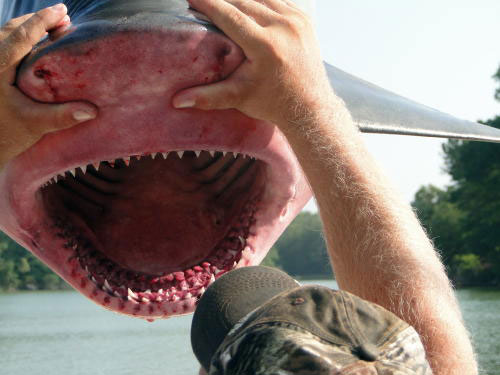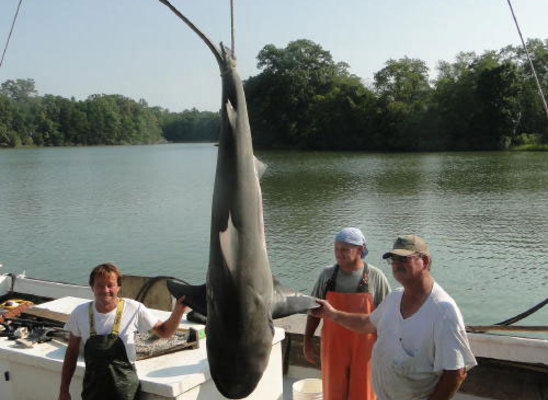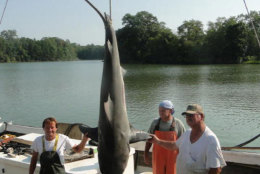



Paul D. Shinkman, wtop.com
Tw: @ShinkmanWTOP
WASHINGTON – Sharks are going to hunt down you and your family and won’t rest until they explode. At least, that’s what the 1975 movie “Jaws” would have you believe.
This mindset hijacked the national psyche in the 1980s and 90s, local scientists say, and is precisely why these natural predators need help from conservationists, fishermen and common beachgoers. Regional species, including some dangerous yet rare varieties, are particularly vulnerable yet incredibly important to maintaining the whole maritime ecosystem.
Learning more about these creatures beyond Spielberg’s sensationalist movie is particularly important now, says Robert Latour, associate professor at the Virginia Institute of Marine Science, one of the leading authorities on shark behavior.
“Following the release of those movies, psychology about sharks changed tremendously,” says Latour. “The number of animals being harvested, whether they were for legitimate reasons or just to kill them and get rid of them, went up markedly.”
“It was, ‘Let’s go kill sharks,’ the macho, fun, cool thing do to, and also, ‘Let’s get rid of them because of their potential for harming people,'” he says.
Seemingly dangerous sharks have made headlines recently. Latour believes seal preservation efforts are likely what caused great white sharks to patrol the shores of Cape Cod for their favorite meal. An unusually warm winter and summer in the Mid-Atlantic area also opens the door for unprecedented migratory habits for species like tiger and sand tiger sharks.
Incidents like the 8-foot bull shark caught at the mouth of the St. Mary’s River in Southern Maryland further feed the hype of a potential shark attack. Latour says any kind of shark attack remains very rare.
“You have a greater probability of getting into a car wreck today than you do of getting attacked by a shark at the beach,” he says.
It wasn’t until the 1990s that local governments began taking direct action to protect these predators. VIMS has been working to build more data on sharks’ habits since that time, when very little was known about them.
It’s slow work. Sharks live for a long time and are very slow to grow and reach maturity. Unlike fish, some sharks give birth to live young and usually have less than a dozen pups. Females in some shark species may even take a year off from producing young, unlike female fish that can produce millions of eggs multiple times a year, making it easier for them to repopulate.
As shark populations diminish, other species beneath them in the marine “food web” rise in numbers, says David Secor, a professor with the University of Maryland Center for Environmental Science.
Fewer sharks means more of their usual prey, such as rays and skates. More of these animals means fewer of the species upon which they prey. This trickle-down effect will eventually begin to harm populations of species far away from sharks in the food web, such as clams.
(Food webs expand upon the traditional thinking of a food chain, and depict the interactivity of an entire ecosystem where multiple predators have multiple prey, instead of a singular link of animals.)
“It’s a top-down effect,” says Secor. “Even though we have increased conservation measures in place now, they weren’t there a decade, two decades ago. By that time, the damage was done.”
But sharks are out there. Secor and Latour come across the dogfish, mako, thresher, sandbar and sand tiger species of shark in their work. These are generally not dangerous, unlike the tiger and bull sharks that are known to be more aggressive and exist off the coasts of Maryland, Delaware and Virginia and at the mouth of the Chesapeake.
Even with the presence of these sharks and the large swaths of area beaches, there have been no shark attacks in Maryland since 1670, and there have only been five in Virginia, according to data from the Florida Museum of Natural History at the University of Florida . Only one of those, in 2001, was fatal.
Shark populations continue to rise, thanks to conservation efforts that regulate commercial fisheries and sport fishing.
“There are some good trends going on,” says Secor. “The U.S. internationally has been very proactive in the shark fin ban, which is one of the most horrendous types of shark fishing that goes on.”
Latour expects to have more data by the end of this year on the shifting migratory habits of sharks. The warmer water means a proliferation of species up the coast. This could conceivably bring with it more bull sharks, which can survive the low salinity rates of the Chesapeake that usually keep other sharks at bay.
Follow WTOP on Twitter.
(Copyright 2012 by WTOP. All Rights Reserved.)







